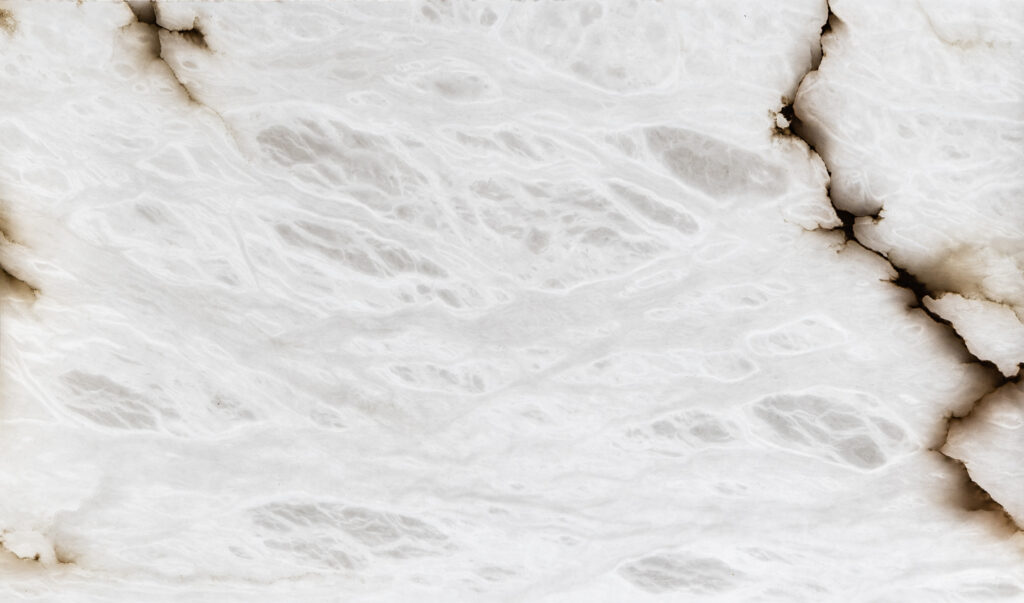At first glance, alabaster and marble are two materials that are often confused. Both are natural stones with a similar appearance, yet each one has unique features that set it apart.
So, which is better—alabaster or marble? If you’re in the middle of an architectural project or renovation and can’t decide between the two, don’t worry.
At Arastone, we are alabaster specialists, and in this article, we’ll explain in detail the differences between marble and alabaster so you can make an informed choice.
Characteristics of marble
To begin with, marble is a natural metamorphic stone formed from limestone that has been subjected to high temperatures and pressure over millions of years.
It is composed mainly of calcium carbonate (CaCO₃), which gives it a compact, durable, and resistant structure. That’s why it has been used for centuries in classical sculptures, as well as in grand buildings and homes of all kinds.
Here are the main technical and aesthetic characteristics of marble:
- Hardness: Scores 3 on the Mohs scale, making it harder than alabaster (which scores 2).
- Density: Around 2.7 g/cm³, which also makes it heavier than alabaster.
- Durability: Offers good resistance to scratching, wear, and humidity, though it’s advisable to seal it in humid or outdoor environments.
- Aesthetics: Forms opaque surfaces with elegant veining in tones ranging from white to black, green, or pink, depending on its mineral impurities.
- Polish: Can achieve very glossy finishes, ideal for adding a timeless, luxurious look to any space.
Differences between marble and alabaster
Although they may look similar, there are several key differences between marble and alabaster. When deciding which one is better suited to your specific project, it’s important to keep these distinctions in mind:
- Finish: The most noticeable difference is the finish. Alabaster is translucent and allows light to pass through, creating unique lighting and design effects. Marble, on the other hand, is opaque.
- Weight: Alabaster is lighter than marble, making it easier to install in certain architectural elements or suspended decorative features.
- Craftsmanship: Being softer, alabaster is easier to carve and shape, making it ideal for creating custom forms and details. Marble is harder and requires more specialized tools, making it more costly to work with.
- Resistance: While marble is more resistant to impact, scratches, and moisture, alabaster requires more delicate care.
- Price: Which is more expensive—marble or alabaster? It depends. But high-quality alabaster, like the kind we work with at Arastone, can be more valuable than conventional marble due to its exclusivity, handcrafted finish, and unique properties.
Both materials are noble choices, but alabaster stands out for its exceptional natural beauty and its ability to transform light. Marble, meanwhile, is a solid option when resistance and durability are top priorities.

Applications in projects
Given their properties, both alabaster and marble have prominent applications in architecture and interior design. The decision between them depends on how you plan to use them and the aesthetic effect you want to achieve
- Marble is commonly used in flooring and staircases in high-traffic areas, kitchen and bathroom countertops, wall cladding, exterior façades, and structural elements.
- Alabaster is the perfect alternative for lighting fixtures and backlit features, decorative wall panels, custom furniture, and luxury interior design details—particularly in projects aiming for exclusivity and a unique visual identity.
If you now understand the difference between marble and alabaster but still aren’t sure which one to choose, remember: it’s not just about hardness or price. Think about the visual language you want your space to communicate. Do you want it to radiate warmth and sophistication? If so, alabaster is an unmatched choice—especially when it’s high-quality alabaster.
At Arastone, we bring your dream projects to life with our alabaster panels. We extract and process this unique stone directly from our own quarries in Aragón, which allows us to offer exceptional quality and custom finishes.
If you’re interested in our services or have any questions, don’t hesitate to get in touch!
